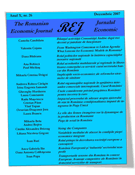Abstract:
In the Tunisian context, the issue of the misalignment of the real exchange rate has arisen for some time for some reason, a question that has intensified after the adoption of the floating regime. In this article, we will look at the assessment of the effects, if any, of the misalignment of the real effective exchange rate (REER) to its equilibrium value over the period from 1986 to 2015. The results show that the equilibrium level of the long-run exchange rate depends on productivity, the terms of trade and government spending. Two sub-periods are noted, that of a positive mismatch (undervaluation) from 1986 to 2003 followed by another negative mismatch (overvaluation) from 2004 to 2015. Such a result can be explained by the orientation of Tunisia towards the flexibility of the real exchange rate which in turn is likely to reduce the degree of imbalance of the real exchange rate. Similarly, the Tunisian authorities must adopt gradual reforms in their decisions on liberalization and financial integration and they are called upon to strengthen their trade and exchange policies to meet the challenge of the new international financial architecture. Finally, concerning the misalignment, we found the difference between the observed exchange rate and the equilibrium exchange rate is very low, especially since the implementation of the structural adjustment plan.
